
Nursing Leadership Academy Develops Current and Future Leaders
Staggering shortages and the need to retain nurse leaders have become an inevitable reality of the near future. However, the present holds opportunities to support succession planning for the nurse leaders, which is essential for the vitality of health care organizations. Even before the pandemic, health care organizations were seeing the retirements of leader nurses exceed the number of replacements for those positions, resulting in a vast loss of experiential wisdom and organizational acumen (Warshawsky & Cramer, 2019). It is estimated an additional 67,200 nurse leaders are needed in the United States. Programmatic offerings by health care organizations to build and support nursing leaders are essential, as investing resources into high-potential talent will yield future gains (Graystone, 2019). One way to make that investment is through a nursing leadership development program, as in place at Yale New Haven Health System (YNHHS) in Connecticut. This article follows the development of this program, which has had 105 past participants and 104 current participants.
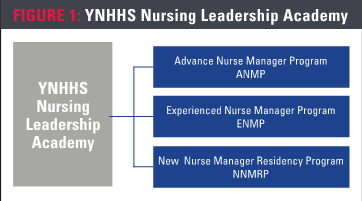
Because of the difficulty in attracting and retaining nurse leaders at the nurse manager level, in 2013 the chief nursing officer at Yale New Haven Hospital, a 1,541-bed Magnet-designated academic medical center, initiated a partnership with the health system’s Institute for Excellence (IFE) and the Yale School of Management. This partnership worked to create a leadership development program aimed at strengthening the competencies of nurse managers. The Nursing Leadership Academy was developed and provided a structured approach to identify, develop and retain high-caliber talent. In 2013, the Advanced Nurse Manager Program (ANMP) launched as the inaugural program. Due to its initial results and feedback from participants in the program, the ANMP was expanded to the health system, with cohorts beginning in 2016. Later, two additional programs were created (Figure 1): the Experienced Nurse Manager Program (ENMP) and the New Nurse Manager Residency Program (NNMRP). This health system investment in nursing leadership has resulted in both strengthening competencies as well as preparing nurse leaders to assume expanded and higher-level roles, assisting with succession planning.
Succession planning strategy
The Nurse Leadership Academy strives to create a talent pipeline of successors, allowing YNHHS to have minimal disruptions in operations and enhance the systems’ ability to fulfill its mission of innovation and excellence in patient care, teaching, research and service to its communities. Career progression throughout the organization is supported and achieved through nursing leadership succession in a variety of roles (Frasier, 2019; Warshawsky & Cramer, 2019; Webb, Diamond-Wells, & Jeffs, 2017). A thoughtful succession planning strategy for professional development is necessary to devise focused programs to build knowledge, competencies and needed skills to build future nursing leader talent (West et al., 2016). The steps to devise a successor planning strategy include securing the potential nurse leader talent, realizing the needed nurse leader competencies and initiating the leadership development programs. The following sections give a brief overview of each phase.
Securing potential talent
Beginning with a succession planning tool, the performance/potential grid (Figure 2), current talent and potential leaders were identified. This assessment tool is used by the leader of a nurse manager to assess potential talent, which then results in placing the individual in one of the nine boxes on a grid. This method of evaluation drove the selection of candidates for the ANMP and the ENMP cohorts.
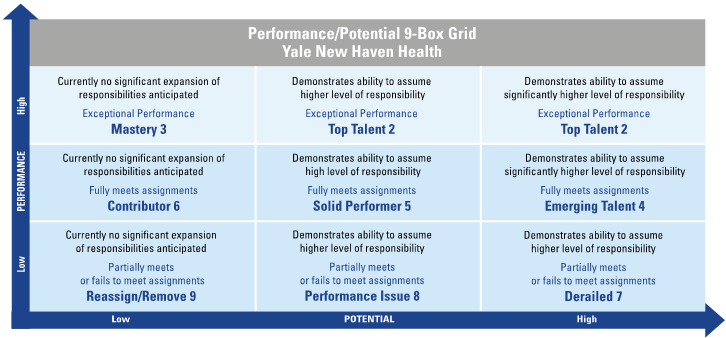
Defining competencies
Understanding the competencies needed for nurse leaders assuming new roles is an essential component of an effective succession plan. Incorporating a succession planning strategy that matches competencies needed for future nurse leaders is an essential tactic to a successful leadership trajectory plan (Warshawsky & Cramer, 2019). The AONL Nurse Manager Competencies, (2015), Korn-Ferry Leadership Architect Global Competency Framework (2016), and YNHHS core leadership competencies were utilized to build the content for each program (Figure 3).
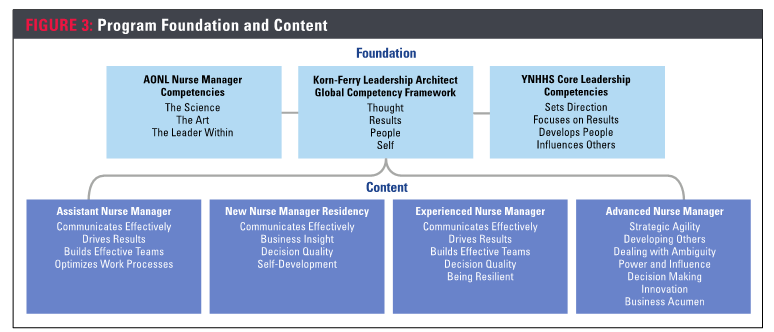
Program development
Some commonly recommended components for successful leadership development programs include formal identification of succession candidates and formal program implementation, didactic sessions, experiential learning and reflective practices. In addition, experts recommend that participants complete a project and use the services of a coach and mentor. (Ramseur et al., 2018).
Learning and development framework
The literature supports devising a framework for nursing leadership programs with specific leadership competencies (Frasier, 2019; Moreno & Girard, 2019; Warshawsky & Cramer, 2019). Theoretical frameworks for leadership development programs provide support for the continuity of leadership skills and consistent messaging (Frasier, 2019). Each leadership academy program, which was six months in length, was designed using the Center for Creative Learning’s 70/20/10 model (Figure 4). This model develops competencies through working on project teams or challenge assignments (70%), receiving coaching and/or mentoring (20%), and attending classroom instruction in various venues (10%). The EMNP design, based on the 70/20/10 model, is shown in Figure 5.
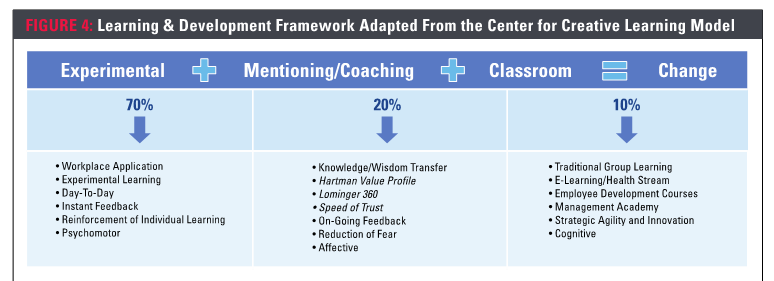
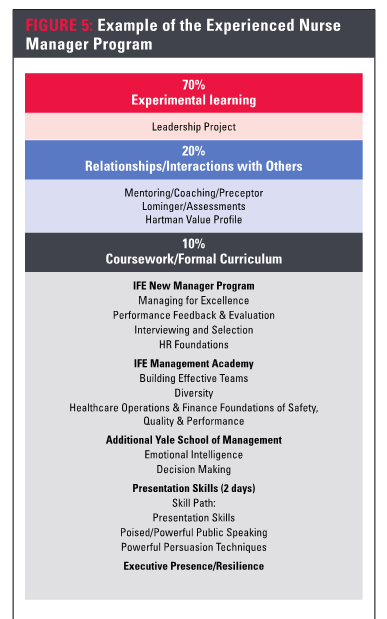
Mentors and coaches
Mentor and coach programs have been identified as essential components of a development program for emerging nurse leaders, to enhance their growth and success (Cabral et al., 2019). In the leadership academy program, mentors were provided to all participants, with guidelines for the mentor and mentee. These mentors were senior vice presidents and vice presidents for the ANMP participants. ENMP participants received guidance from executive directors and directors, in addition to clinical program director and nurse manager alumni from prior ANMP or ENMP cohorts. Certified executive coaches from the health system’s IFE were provided for the participants in the ANMP and ENMP.
Didactic sessions
For the didactic portion of the leadership development programs, partnerships with academia have proven to be successful (Webb et al., 2017). The academic partnership with Yale School of Management was an essential component of the leadership academy. Talented professors, who were experts in their field of study, taught courses in relation to the identified competencies. The IFE’s Management Academy courses, which were taught on the Yale School of Management campus, provided the foundation of learning for each development program and provided an enhanced learning environment for the nursing leaders.
Projects
The assignment of capstone projects to the nurse leader cohorts is an effective leadership skills learning method (Stamps et al., 2019). Each leadership academy program requires a project to be completed using a team model. This program feature gives participants opportunities to exercise some of the identified competencies such as building effective teams, communicating effectively and driving results. With the guidance of a team, these projects have made changes throughout the YNHHS. One example is the RN advancement program, which was a project adopted by a team in the leadership academy. The team’s work served as the foundation for the development of a systemwide clinical ladder program. Another team’s project, related to patient satisfaction, included the development of a plan to understand the fundamental needs and wants of the YNHHS patients and customers, addressing access, quality, safety technology and trust within the system. The plan included the use of technology to improve patient experience and to enhance patient rounding with purpose. An electronic tablet equipped with rounding questions became instrumental for capturing data, especially during the past 18 months of the COVID-19 pandemic.
The final projects require a presentation to the executive team and a formal document inclusive of current state, business objectives, best practices, proposed solutions, resource requirements and a cost-benefit analysis. These presentations and documents are anonymously scored, along with feedback provided from the executive team. The results are delivered by the coach and/or members of the IFE to support the leader’s continued growth and development.
Modifications to meet needs
Over time, YNHHS leaders saw a need to add a program for the experienced managers whose trajectory was different from that of an advanced manager. While both the ANMP and ENMP used the same didactic methodologies, each focuses on their specific needed competencies for different roles. The ENMP launched in the fall of 2019. A timeline shows the leadership academy’s evolution (Figure 6).

The newest addition to the leadership academy, the New Nurse Manager Residency Program (NNMRP), was launched in the spring of 2021. Originally designed as two separate programs for nurse managers and assistant nurse managers, it was modified due to the impact of COVID-19, delaying the launch of each. There were minor differences in the objectives, content and competencies. This required consolidation has been successful, noting overlap in original program designs. The NNMRP utilized the Sigma Theta Tau curriculum, blended with IFE content and additional specialty courses covering crucial conversations, nursing budgets, Magnet standards, the nursing professional practice environment and leading diverse teams.
Career progress
The leadership academy’s programs have resulted in participant career advancement. One leadership academy program saw 25% of its first cohort promoted within the first year (Stamps et al., 2019). In the eight years since the inaugural 2013 leadership academy program, 76% (n=23) retained, while 72% advanced to a higher position or had role expansion within the organization. An average advancement of 10% of participants occurred per year. The 2016 program advancement rate is 40% (n= 27) at the five-year mark, an average of 8% per year. The 2018 program has had an advancement rate of 12% at the three-year mark with an average of 6% advancement per year. As we approach the tenth year of the program, a thoughtful review of the competencies and program content is occurring to address issues regarding organizational success factors, health equity, diversity, equity and inclusion, resiliency and the multigenerational workforce. Even if an organization’s resources are limited, the creation of a leadership development program is still recommended and can be accomplished through improvising tactics and scaling it to the organizational needs and available support. Such a program is fundamental to an organization’s success because having a formal strategic succession plan in place has broad implications that support the delivery of quality care, thriving employee engagement and healthy bottom lines. (Phillips et al., 2018)
In addition, feedback from participants validates the importance of leadership academy programs. These statements from ENMP program alumni highlight the experience:
“Thank you for this amazing opportunity and experience!”
“It has been both professionally and personally rewarding and I am very thankful for having this opportunity.”
“What a pleasure to be a part of this cohort.”
“It is the highlight of my career. Thank you for believing in us and our leadership development!”
References
Cabral, A., Oram, C., & Allum, S. (2019). Developing nursing leadership talent-Views from the NHS nursing leadership for south-east England. Journal of Nursing Management, 27(1), 75-83. doi:10.1111/jonm.12650
Frasier, N. (2019). Preparing nurse managers for authentic leadership: A pilot leadership development program. Journal of Nursing Administration, 49(2), 79–85. https://doi.org/10.1097/nna.0000000000000714
Graystone, R. (2019). Why you need a plan. Journal of Nursing Administration, 49(7-18), 343-344. doi:10.1097/NNA.0000000000000764
Jones, B. W. (2019). Creating a culture of promoting from within. Dimensions of Critical Care Nursing, 38(1), 50-53. doi:10.1097/DCC.0000000000000330
Moreno, J. V., & Girard, A. S. (2019). Capitalizing on an existing shared governance structure in developing leadership succession planning. Journal of Nursing Administration, 49(4), 193-200. doi:10.1097/NNA.0000000000000737
Phillips, T., Evans, J. L., Tooley, S., & Shirey, M. R. (2018). Nurse manager succession planning: A cost-benefit analysis. Journal of Nursing Management, 26(2), 238-243. doi:10.1111/jonm.12512
Ramseur, P., Fuchs, M. A., Edwards, P., & Humphreys, J. (2018). The implementation of a structured nursing leadership development program for succession planning in a health system. Journal of Nursing Administration, 48(1), 25-30. doi:10.1097/NNA.0000000000000566
Stamps, D. C., Beales, S., & Toor, M. (2019). A model to streamline career progression for nurse managers and retain emerging leaders. Nursing Management, 50(10), 28-34. doi:10.1097/01.NUMA.0000580600.38004.c1
Warshawsky, N., & Cramer, E. (2019). Describing nurse manager role preparation and competency: findings from a national study. Journal of Nursing Administration, 49(5), 249-255. doi:10.1097/NNA.0000000000000746
Webb, T., Diamond-Wells, T., & Jeffs, D. (2017). Career mapping for professional development and succession planning. Journal for Nurses in Professional Development, 33(1), 25-32. doi:10.1097/NND.0000000000000317
West, M., Smithgall, L., Rosler, G., & Winn, E. (2016). Evaluation of a nurse leadership development programme. Nursing Management (Harrow), 22(10), 26-31. doi:10.7748/nm.22.10.26.s29
About the Authors
Stephanie Bilskis, MBA, RN, NEA-BC, is the nursing clinical operations coordinator for patient services at Yale New Haven Hospital in Connecticut.
Jennifer Ghidini, MSN, FNP, CNML, is the executive director of medicine services, at Yale New Haven Hospital in Connecticut.
Ena Williams, MBA, RN, CENP, is senior vice president and chief nursing officer for Yale New Haven Hospital in Connecticut.


